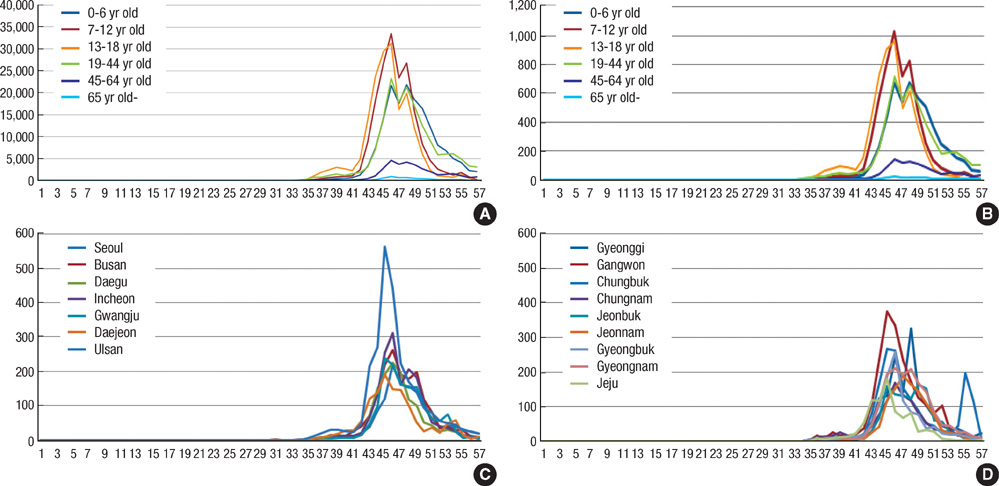The Spread of Pandemic H1N1 2009 by Age and Region and the Comparison among Monitoring Tools
- Affiliations
-
- 1Korea Centers for Disease Control and Prevention, Seoul, Korea. docmohw@mw.go.kr
- KMID: 1792969
- DOI: http://doi.org/10.3346/jkms.2010.25.7.1109
Abstract
- This report describes the pattern of the spread of the pandemic H1N1 2009 and compares 3 monitoring tools until the 57th week or January 31, 2010. The 1st week was from December 28th, 2008 to January 3rd, 2009. A total of 740,835 patients were reported to be infected with pandemic H1N1 2009 and 225 patients were reported to have died of pandemic H1N1 2009. The number of patients aged from 7 to 12 was the largest (183,363 patients in total) but the virus spread and then was suppressed most quickly among the children between 13 and 18. The region-determinant incidence of patients showed diverse patterns according to regions. The peak of the ILI per thousand was at the 45th week, the number of antiviral prescriptions reached its peak at the 44th week, and the peak based on reported patients was the 46th week. As of February 3 2010, the outbreak passed through the peak and has gradually subsided. Now it is time for the government and the academic world to review this outbreak, efficacy of vaccination, and further preparation and response for the next pandemic.
Keyword
MeSH Terms
-
Adolescent
Adult
Age Distribution
Antiviral Agents/therapeutic use
Child
Child, Preschool
*Disease Outbreaks
Humans
Infant
Infant, Newborn
Influenza A Virus, H1N1 Subtype/*pathogenicity
Influenza Vaccines/therapeutic use
Influenza, Human/drug therapy/*epidemiology/mortality
Korea/epidemiology
Middle Aged
Sentinel Surveillance
Young Adult
Figure
Cited by 5 articles
-
Emerging Infectious Diseases in the Republic of Korea
Myoung-don Oh
Infect Chemother. 2011;43(6):453-457. doi: 10.3947/ic.2011.43.6.453.Incidence and Epidemiological Characteristics of 2009 Pandemic Influenza A (H1N1) Among School-Based Populations in Korea
Hyun Jung Kim, Byung Chul Chun, Hoo Jae Hann, Jang Wook Sohn, Sae Yoon Kee, Si Hyun Kim, Myoung Youn Jo, Kyung Young Lee, Seok Hyeon Lee, Min Ja Kim, Hyeong Sik Ahn
Infect Chemother. 2012;44(6):431-438. doi: 10.3947/ic.2012.44.6.431.2009 Pandemic Influenza A(H1N1) Infections in the Pediatric Cancer Patients and Comparative Analysis with Seasonal Influenza
Soo Han Choi, Keon Hee Yoo, Kangmo Ahn, Ki Woong Sung, Hong Hoe Koo, Yae Jean Kim
Korean J Pediatr Infect Dis. 2012;19(2):61-70. doi: 10.14776/kjpid.2012.19.2.61.Did the 2009 Influenza A (H1N1) Virus Caused more Severe Infection than Seasonal Influenza during 2009 to 2010 Season?
Yae-Jean Kim
Pediatr Allergy Respir Dis. 2011;21(4):247-249. doi: 10.7581/pard.2011.21.4.247.Introduction and Administration of the Clinical Skill Test of the Medical Licensing Examination, Republic of Korea (2009)
Kun Sang Kim
J Educ Eval Health Prof. 2010;7:4. doi: 10.3352/jeehp.2010.7.4.
Reference
-
1. Influenza A(H1N1) - update 9. 2009. WHO. accessed 2 May 2009. Available at http://www.who.int/csr/don/2009_05_02/en/index.html.2. Kim JH, Park HK, Kim JS, Lee SW, Kim SS, Lee JK. An outbreak of novel influenza A (H1N1) in the English Institute. J Prev Med Public Health. 2010. 43(3):in press.3. Population based on the Resident Registration. Statistics Korea. accessed 15 April 2010. Available at http://kosis.kr/nsp/wnsearch/totalSearch.jsp.4. Donaldson LJ, Rutter PD, Ellis BM, Greaves FE, Mytton OT, Pebody RG, Yardley IE. Mortality from pandemic A/H1N1 2009 influenza in England: public health surveillance study. BMJ. 2009. 339:b5213.
Article5. Echevarria-Zuno S, Mejia-Arangure JM, Mar-Obeso AJ, Grajales-Muniz C, Robles-Perez E, Gonzalez-Leon M, Ortega-Alvarez MC, Gonzalez-Bonilla C, Rascon-Pacheco RA, Borja-Aburto VH. Infection and death from influenza A H1N1 virus in Mexico: a retrospective analysis. Lancet. 2009. 374:2072–2079.6. Kamigaki T, Oshitani H. Epidemiological characteristics and low case fatality rate of pandemic (H1N1) 2009 in Japan. PLoS Curr Influenza. 2009. RRN1139.
Article7. Glezen WP, Couch RB. Interpandemic influenza in the Houston area, 1974-76. N Engl J Med. 1978. 298:587–592.
Article8. Mossong J, Hens N, Jit M, Beutels P, Auranen K, Mikolajczyk R, Massari M, Salmaso S, Tomba GS, Wallinga J, Heijne J, Sadkowska-Todys M, Rosinska M, Edmunds WJ. Social contacts and mixing patterns relevant to the spread of infectious diseases. PLoS Med. 2008. 5:e74.
Article
- Full Text Links
- Actions
-
Cited
- CITED
-
- Close
- Share
- Similar articles
-
- Epidemiology, clinical manifestations, and management of pandemic novel Influenza A (H1N1)
- The Diagnosis and Treatment of Influenza
- A Case of Oseltamivir-Resistant Pandemic Influenza (H1N1 2009)
- The 2009 H1N1 Pandemic Influenza in Korea
- Clinical Characteristic of Respiratory Tract Infections in Children during Pandemic Influenza (H1N1 2009) in Korea



